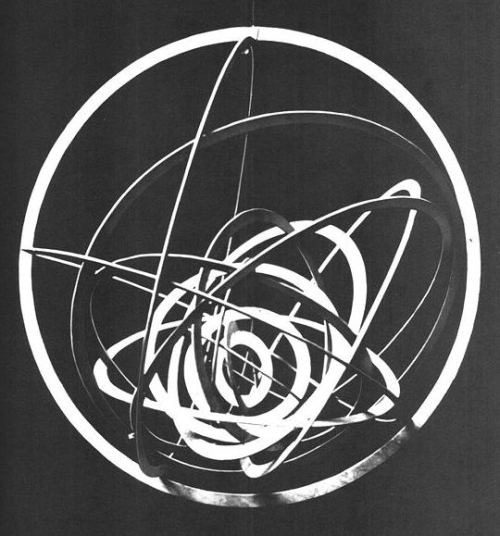Rodchenko, in particular, began his career during the Russian Civil War, in which various groups and interests across Russia sought to counteract the recently successful Bolshevik Revolution of 1917 led by Vladimir Lenin. It was in the midst of the Civil War, in 1921, that Rodchenko and a small group of artists developed a new style of art that would eventually be known as Constructivism.
Constructivism is characterized by works made out of construction materials, mainly metal and wood. Because of this, most Constructivist works are physical three-dimensional sculptures. The Constructivist works that are two-dimensional forsake the use of traditional oil paint for the most part, preferring instead less conventional techniques including photography and graphic design.
For the three-dimensional works, one of Rodchenko's most notable works is Hanging Construction.
 |
| Hanging Construction, Aleksandr Rodchenko, 1920, Wood. |
While the work no longer exists, Hanging Construction demonstrates the Constructivists' interest in geometry and mathematics, and is one of the first sculptures to have the illusion of movement within its frame. Personally, I have a metal and plastic gimmick on my nightstand at home that has a very similar appearance to Hanging Construction. Both my gimmick and Hanging Construction are similar to the shape of an atom; Neils Bohr proposed in 1915 that atoms consist of a nucleus orbited by electrons, so this sculpture appears to be a tribute to Soviet Russia's deadly fascination with the atom. Given that the Manhattan Project successfully detonated the first nuclear bomb just 25 years after Hanging Construction was completed, the work stands as an omen of the incoming Nuclear Age.
When Rodchenko wasn't busy making wooden and metal models, he was making graphic designs and taking photographs to promote the Soviet Union's Marxist ideals of uniformity. Working for a variety of magazines, Rodchenko often took photographs of groups of people from dramatic angles, allowing readers to look at themselves like never before.
 |
| One of Rodchenko's many photographs, offering a bird's-eye view of a group of people in identical white shirts lining up in a formation. |
After forsaking traditional painting in 1921, Rodchenko also created posters alongside his photographs.
 |
| One of Rodchenko's many posters. The speech bubble reads "Books!" |
The Soviet Union was established in 1922 and lasted until 1991. While everything that has happened since then is history, visual propaganda such as Rodchenko's played a major part in controlling the Soviet population, half of which was illiterate. Of course, graphic design and photography are still a major part of modern magazines, and that demonstrates the power of images.
| It is just a wallpaper that I found online, but just imagine seeing Earth from an angle like this! |
For more on the Bohr model, visit:
http://chemistry.about.com/od/atomicstructure/a/bohr-model.htm
For a brief history on nuclear research, visit:
http://www.fi.edu/guide/wester/history.html
To see more of Rodchenko's photographs, visit:
http://www.csun.edu/~pjd77408/DrD/Art461/LecturesAll/Lectures/lecture07/Rodchenko.html
For a brief overview of photography, visit:
http://inventors.about.com/od/pstartinventions/a/Photography.htm
On Soviet literacy:
http://www.ft.com/cms/s/2/b8cbd3fe-28ee-11e0-aa18-00144feab49a.html#axzz1Z15QubTV
No comments:
Post a Comment